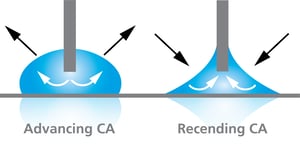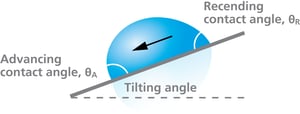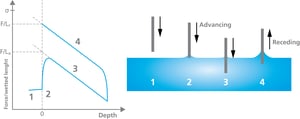Measuring contact angle hysteresis can give a lot of additional information on your surface. The measurement methods can be divided into optical (needle and tilting methods) and force (Wilhelmy method) depending on the measurement principle used. All the methods are measuring advancing and receding contact angles which are used to calculate contact angle hysteresis. All of these methods have their pros and cons which makes some more suitable for certain types of substrates and applications.
Needle method is the first one of the optical methods. Here, a needle is brought close to the substrate surface and the liquid is dispensed slowly to increase the volume of the drop.  As the contact line between the substrate and the drop is increasing, the advancing contact angle is measured. When the liquid is sucked slowly off the substrate and the contact line is withdrawing, the receding contact angle is measured. The method is used especially with superhydrophobic samples, as this is the only practical method for such a high contact angle substrate.
As the contact line between the substrate and the drop is increasing, the advancing contact angle is measured. When the liquid is sucked slowly off the substrate and the contact line is withdrawing, the receding contact angle is measured. The method is used especially with superhydrophobic samples, as this is the only practical method for such a high contact angle substrate.
Tilting method is the second optical method. The droplet is placed on the substrate to be measured and the tilting of the sample is started.  The advancing and receding angles are measured at the point at which the droplet starts to move on the substrate. At the same point, the roll-off angle can be defined. The method allows for the mapping of the substrate but is often criticized as the size of the drop can have an impact on the measured values. A large enough and same drop volume should be used to allow comparison between different substrates.
The advancing and receding angles are measured at the point at which the droplet starts to move on the substrate. At the same point, the roll-off angle can be defined. The method allows for the mapping of the substrate but is often criticized as the size of the drop can have an impact on the measured values. A large enough and same drop volume should be used to allow comparison between different substrates.
Wilhelmy method is based on the force measurement. The object to be measured, a rectangular plate or round rod, is immersed into a liquid with the known surface tension.  As the plate or rod is immersed, the advancing contact angle is measured and when the plate is emerged, the receding angle is obtained. The dimensions of the plate or the diameter of the rod needs to be known and the measured contact angles are averaged over the whole area immersed into the liquid. Thus the method is best suited for objects, like thin fiber, which measurement is difficult with other methods.
As the plate or rod is immersed, the advancing contact angle is measured and when the plate is emerged, the receding angle is obtained. The dimensions of the plate or the diameter of the rod needs to be known and the measured contact angles are averaged over the whole area immersed into the liquid. Thus the method is best suited for objects, like thin fiber, which measurement is difficult with other methods.
If you would like to read more about contact angles and their measurement methods, please download the white paper below.
Receding contact angle is the lowest possible contact angle on a given surface. Receding angle is measured on previously wetted surface.
Contact angle hysteresis can tell you about the homogeneity of your surface coating.
One should always measure the advancing and the receding contact angle to get the true picture of the surface wettability.
Due to a wide range of applications, the measurement of wettability, i.e., the contact angle measurement can be done with several different methods.
More and more research interest is being put on functional coatings. New measurement techniques are required to evaluate them.
Contact angle hysteresis is often measured with so-called tilting cradle or plate method. The measurement can be done either manually or automatically.
Dynamic contact angle measurements with the needle method has been automated for reliable and repeatable results.
Contact angle hysteresis (CAH) is an important physical phenomenon. When you look through the window on a rainy day, you have probably noticed that some of the water droplets stick to the glass even though gravity is pulling them down. The phenomenon can be explained by contact angle hysteresis.
